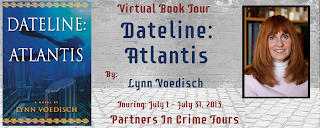 While Amaryllis is hardly a female Indiana Jones, and the story dives (pun intended) a little too much into the mystical depths of Atlantis for my tastes, I still found this to be a thoroughly satisfying read. Dateline: Atlantis is a bit predictable at times, as if Lynn Voedisch were conscious of trying to touch on all the standard elements of the genre, but it also contains enough surprises, genuine thrills, and awe-inspiring details to make it worth a read.
While Amaryllis is hardly a female Indiana Jones, and the story dives (pun intended) a little too much into the mystical depths of Atlantis for my tastes, I still found this to be a thoroughly satisfying read. Dateline: Atlantis is a bit predictable at times, as if Lynn Voedisch were conscious of trying to touch on all the standard elements of the genre, but it also contains enough surprises, genuine thrills, and awe-inspiring details to make it worth a read.
Voedisch wastes little time taking us into the subterranean and underwater ruins, painting a vivid picture of an ancient civilization lost as much to the waters as to time. The level of detail is just about perfect, offering enough to satisfy readers with an interest in archaeology, but not so much as to lose readers who are more interested in the mystery and adventure.
As I said, Amaryllis is hardly an Indiana Jones (or even a Robert Langdon), she is still an interesting heroine, and more than capable of carrying the story. The proverbial dogged reporter, she pairs professional diligence with personal enthusiasm for her quest. Gabriel is probably my favorite character in the novel, a man of secrets who clearly knows more about Atlantis than he's letting on, but who is everything you could ask for in a sidekick. As much as I disliked the man and his motives, Landon Hewitt makes for an interesting foil, a museum archaeologist who is willing to hide or destroy the truth of history to preserve the biblical mythology of his employers.
Like I said, the mystical element was a bit too heavy for my tastes, and I found some of the crystal scenes confusing, but the conflict between faith and history was strong enough to counter it. I wasn't quite sure where Voedisch was leading us, and precisely how she'd wrap up all of the elements, but the final scenes are just as satisfying as the initial explorations.
αωαωαωαωαωαωαω

αωαωαωαωαωαωαω
Author Bio:

Lynn Voedisch is a Chicago writer who had a long career as a newspaper reporter and worked for 17 years at the Chicago Sun-Times. She also freelanced for many other publications, both in print and online. She lives with her husband and pet cat three blocks from the Chicago border. Her son, a new attorney, lives in the city. Her hobbies are tennis, tai ch, an promoting the appreciation of literature.
Catch Up With the Author:



αωαωαωαωαωαωαω
Read an excerpt:
She dives underneath the waves. Next to her is the tip of a giant stone structure. It widens as it plunges down to the ocean floor, filling her line of sight. She surfaces and swims toward the top of the rock. Amaryllis fights for breath as the waves roll up toward her chin and away. She dives again. The structure is a pyramid, without a doubt. It can’t be a natural formation. Its lines are too regular. The stones used to fit the pyramid together are huge—twenty-ton boulders at least—yet they are meshed with knife-edge precision. She can’t get her fingernail between them. Another thing occurs to her: this pyramid is not built in steps, but is smooth-sided like the monuments of Egypt.
She bobs up and down, diving and surfacing for a quarter of an hour, finding more impossible things. These walls, unlike those of the Maya structures they found on land, are still smooth. They are weathered and pitted, but not covered over with barna- cles and seaweed. She sees the remnants of writing carved into the rock near the top, but can’t tell what language it is. It has neither the pictorial intricacy of Maya glyphs nor the simplicity of Roman characters. It has a modern aspect, clean and stylized, proportionally balanced, as if it were a font designed by an adver- tising agency. Yet, some of the figures recall the ancient themes of the American Indians: swirling vortices, men with large heads, hunting dogs. The most prominent of all symbols is a cross in- scribed with concentric circles.
Amaryllis’ strength is nearly gone, but she dives once more if only to give the fullest of reports to her cohorts sleeping back onshore. She slips below the surface and feels along the eastern wall, pulling herself down. She is looking for a dark square she glimpsed before, gaping and black. It yawns at once before her, its edges wavy in the ocean swells. A sea turtle darts in front of her, and she constricts her lungs. She streaks to the surface, gulps a huge lungful of air and immediately she’s at the opening again. Seconds disappear as she measures the portal. It’s just big enough to slip through, but will she be able to get back out? A shining gem illuminated by a sun ray catches her eye. She swishes inside.
With lungs screaming, she scans a tiny chamber, carved from top to bottom with ancient writing. Gold glints from porticos on the sides. A painting is still visible on the ceiling. A carved hand, claw-like and strong, rests on a pedestal in the center of the space. The red hand holds a stone so beautiful, she can’t bear to leave it. In the filtered sunlight that passes through the door- way, the gem dazzles like Venus in the night sky. The morning star—the guide that Amaryllis can rely on. She grabs the jewel.
Through the door, up to the surface, sucking in the air—she’s free.
αωαωαωαωαωαωαω









